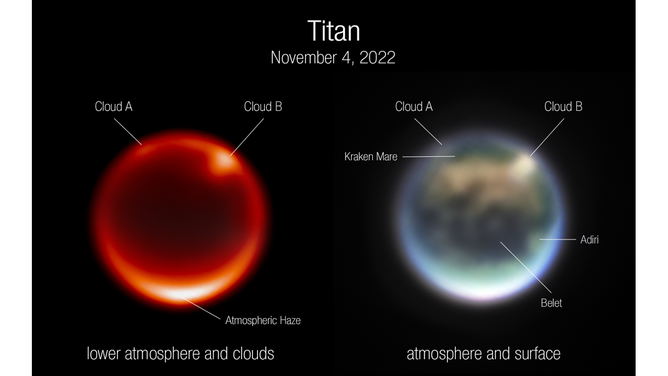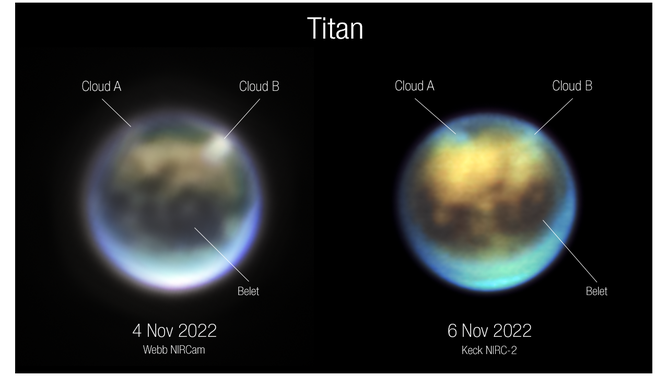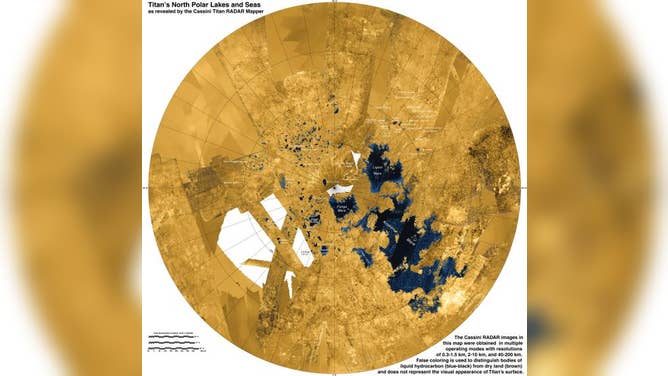Why new James Webb Space Telescope images have scientists excited about clouds on Saturn’s moon Titan
NASA scientists turned to the Keck Observatory in Hawaii to track the evolution and shape of the clouds on Titan found by the James Webb Space Telescope. Atmospheric modeling experts say these help show seasonal weather patterns on Saturn’s moon.
See the latest stunning images taken by the James Webb Space Telescope
The James Webb Space Telescope has released more mesmerizing images of the deepest corners of our universe.
The latest images from the James Webb Space Telescope focus on Saturn's fascinating moon Titan and are already helping atmospheric experts understand weather patterns on another world.
Titan is a fascinating world full of liquid methane and ethane lakes, rain and dune fields.
In a blog post, Conor Nixon, NASA Goddard Space Flight Center planetary scientist and principal investigator of Webb observations of Titan, explained how the first moon images kicked off an exciting collaboration between scientists worldwide.
Nixon said the team had waited for years to use Webb’s Near-Infrared Camera (NIRCam) to study Titan’s atmosphere and weather. In November, they finally got their chance to put the powerful telescope's "eyes" on Titan.

Images of Saturn’s moon Titan, captured by the James Webb Space Telescope’s NIRCam instrument Nov. 4, 2022. Left: Image using F212N, a 2.12-micron filter sensitive to Titan’s lower atmosphere. The bright spots are prominent clouds in the northern hemisphere. Right: Color composite image using a combination of NIRCam filters. (Image Credits SCIENCE: NASA, ESA, CSA, Webb Titan GTO Team IMAGE PROCESSING: Alyssa Pagan (STScI))
"We were absolutely delighted with the initial results," Nixon wrote.
On Nov. 4, James Webb Space Telescope's NIRCam found bright spots on Titan believed to be large clouds.
Quickly, Nixon and others worked on reviewing other images to confirm the spots were, in fact, large clouds.
"Detecting clouds is exciting because it validates long-held predictions from computer models about Titan’s climate, that clouds would form readily in the mid-northern hemisphere during its late summertime when the surface is warmed by the Sun," Nixon said.
To determine if the clouds displayed Earthlike characteristics like moving and changing shape, the team turned to the Keck Observatory in Hawaii to request follow-up observations of Titan's stratosphere to see the clouds' evolution.
"We were concerned that the clouds would be gone when we looked at Titan two days later with Keck, but to our delight, there were clouds at the same positions, looking like they had changed in shape," wrote astronomer Imke de Pater, the Keck Titan Observing Team lead.
Images taken by the ground-based observatory in Hawaii two days after the JWST images showed at least two clouds.
The images below from Webb and Keck have the clouds labeled A and B and one of Titan's most notable features, the dark sand dune region called Belet.

Evolution of clouds on Titan over 30 hours between November 4 and November 6, 2022, as seen by Webb NIRCam (left) and Keck NIRC-2 (right). Titan’s trailing hemisphere seen here is rotating from left (dawn) to right (evening) as seen from Earth and the Sun. Cloud A appears to be rotating into view while Cloud B appears to be either dissipating or moving behind Titan’s limb (around toward the hemisphere facing away from us). (Image Credits SCIENCE: NASA, ESA, CSA, Webb Titan GTO Team IMAGE PROCESSING: Alyssa Pagan (STScI)
(NASA)
According to NASA, clouds on Titan don't last long, so the clouds seen on Nov. 6 could be different from the ones seen on Nov. 4.
Atmospheric modeling experts say these clouds show confirmation of seasonal weather patterns.
DECEMBER WINTER WEATHER OUTLOOK: COLD AIR TO WIN OUT OVER NORTHERN U.S.
The Titan Observing Team is still analyzing data from Webb’s Near-Infrared Spectrograph (NIRSpec) instrument that could reveal more information about the moon's lower atmosphere and surface.
More observations of Titan are planned in May or June 2023 using Webb's Mid-Infrared Instrument.
More Titan time

This colorized mosaic from NASA's Cassini mission shows the most complete view yet of Titan's northern land of lakes and seas. Saturn's moon Titan is the only world in our solar system other than Earth that has stable liquid on its surface. The liquid in Titan's lakes and seas is mostly methane and ethane. (Image: NASA/JPL-Caltech/ASI/USGS)
(NASA)
During NASA's Cassini mission to Saturn, images taken by the spacecraft revealed Titan has similarities to Earth. A European Space Agency probe called Huygens accompanied Cassini into space and touched down on Titan in 2005, becoming the first robot to land in the outer solar system.
JAMES WEBB SPACE TELESCOPE CAPTURES JUPITER'S SWIRLING WEATHER, COLORFUL AURORAS AND RINGS
During the two-hour drop to Titan, the Huygens probe collected data on Titan's atmosphere and then sent back images from the surface. It relayed data and images to Cassini from Titan's surface for about three hours before losing power.
There is still a lot to be learned from Titan. NASA intends to send a small helicopter called Dragonfly back to the surface of Titan in the 2030s.
Incredible images from James Webb show the universe like never before
As the world's premier space science observatory, the James Webb Space Telescope is giving us glimpses into distant worlds like never before.

